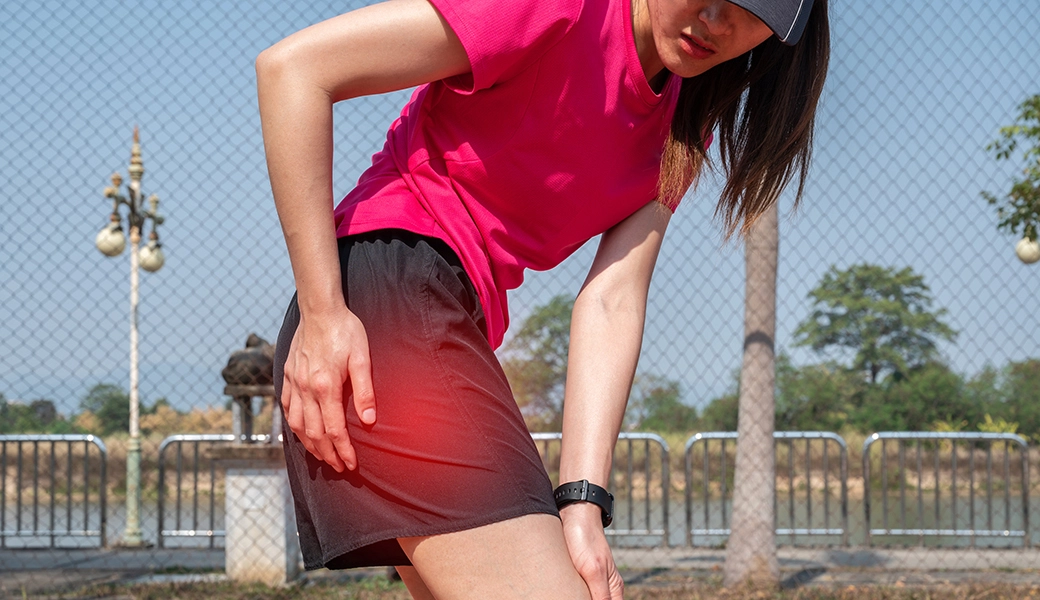Do you think you suffer from a hip labral tear? Do you want to find out for sure? Start by consulting your local Anchorage chiropractor You’ve got a few options:
There are a number of conservative tests to detect hip labral tears. The most common include the Hip Impingement Test, The Straight Leg Raise Test, The FABER Test, and the THIRD Test. Of these, the THIRD is the most effective.
Before we dig into these conservative tests, let’s look at some of the science behind them.
The Science of Hip Labral Tear Tests
A 2009 comprehensive review of hip labral tears published in Springer Link stated that “The most consistent physical examination finding is a positive anterior hip impingement test“ while magnetic resonance arthrography (MRA) is the preferred means of diagnosis.(1) It,further, stated that it often takes as long as two years and multiple medical appointments to get a correct diagnosis.
A 2009 study in Taylor Francis Online looked at the effectiveness of the impingement test, the FABER test, the resisted straight leg raise test, ultrasound, and MR arthrography in diagnosing acetabular labral tears. It concluded that the best clinical test was the impingement test, while MR arthrography remains the gold standard. (2)
A 2011 study in Science Direct also found that Magnetic Resonance Arthrography (MRA) outperformed other methods of diagnosing acetabular labral tears. (3)
In 2014 the Journal for Nurse Practitioners published a study in Science Direct involving 43 patients that found that The Hip Internal Rotation with Distraction (THIRD) physical examination actually outperforms the MRA test. (4)
In 2013, The Journal for Nurse Practitioners published in Science Direct another study that indicated that the THIRD test outperforms even the MRA. (5)
As you can see, the science has changed over the years. For a while, the hip impingement test was the best conservative test, although it could not compete with the MRA. However, the advent of the THIRD Test resulted in a conservative test that actually outperforms even the MRA. Let’s look at these tests more closely.
Types of Conservative Chiropractic Tests for Hip Labral Tears in Anchorage, AK
There are a number of conservative tests for hip labral tears, many of which you will find in use at your local chiropractic clinic in Anchorage and elsewhere. Here are four of the most common.
Hip Impingement Tests
There are two types of hip impingement tests.
The anterior hip impingement test involves the patient lying on his/her back with his/her knee bent at 90 degrees and then internally rotated inward towards the body. If this results in pain, the test is considered positive.
The posterior hip impingement test involves the patient lying on his/her back with his/her hip in extension, and his/her knee flexed and bent at 90 degrees. The leg is then externally rotated. The test is positive if it results in pain or apprehension.
Straight Leg Raise Test
This test (also called the Lasegue Test) is used on a variety of different medical conditions involving back pain. The test begins with the patient sitting or lying down. Then the physician checks the range of motion on the pain-free, uninhibited side. From there, the hip is flexed while the knee is straight. This is done to both legs. The patient may also be asked to flex his/her neck or extend his foot to stretch nerves.
The FABER Test
It stands for Flexion, ABduction, and External Rotation. The test begins with the patient lying on his/her back with his/her legs straight. The leg that is on the same side as your hip pain is placed in a figure four position (the patient bends his knee and places his ankle over the other knee). The physician will then apply downward pressure (toward the table) to the bent knee. The test is positive if you experience hip or groin pain.
The THIRD Test
This (the Hip Internal Rotation with Distraction) test begins with the patient lying on his back. The patient must then flex his/her knee to 90 degrees and turn it inward approximately 10 degrees. The hip is then internally rotated with a downward compressive pressure on the hip joint. This maneuver is then repeated with the joint being slightly distracted (pulled apart). If the patient experiences pain when the hip is rotated, and diminishing pain when distracted while rotated, it is considered a positive test.
Technological Tests
There are a number of technological tests that can be used to detect hip labral tears. Of these, the most effective is the MRA (magnetic resonance arthrography). However, the noninvasive THIRD test may actually be superior to the MRA.

Types of Hip Labral Tears
In this discussion, we are concerned with just two types of hip labral tears.
Anterior Hip Labral Tears
These are the most common types of hip labral tears. They occur in the front part of the hip joint. As a result, your physician will likely suggest you modify your sleeping routine. First, avoid sleeping on your stomach – it is not just bad for an anterior hip labral tear, it’s bad in general. Instead, sleep either on your back or on your uninjured side. You don’t want to sleep directly on the injury because that will increase pressure, likely cause pain, and even aggravate the injury. You do not want to suffer hip labral tear pain at night if it can be avoided.
Posterior Hip Labral Tears
These are hip labral tears that occur on the back of the hip joint. These are somewhat rarer than anterior hip labral tears. As a result, treatment options for posterior labral tears may differ in certain regards from anterior labral tears. One of the most obvious such differences is the sleeping position you are recommended to take. Normally, patients with hip and back issues are instructed to sleep on their back. However, with a posterior hip labral tear, if you sleep on your back you will be creating additional pressure on your injury. As a result, you will most likely be instructed to sleep on your uninjured side so that the side with the tear can get relief.
Chiropractic Care for Hip Labral Tears in Anchorage, AK
It is commonly accepted that in medical care non-invasive conservative treatments should be tried before invasive ones like surgery. In light of that, if you suffer from a hip labral tear, you may find yourself presented with a large number of conservative treatment options. One such option is chiropractic care. In Anchorage, there are many chiropractic clinics available. Our very own Better Health Alaska is ranked as one of the best.
Chiropractors are experts in the musculoskeletal and nervous systems. If you arrive in a chiropractor’s office with a hip labral tear, the chiropractor will likely prescribe a combination of noninvasive treatments. In addition to rest and activity changes, you will probably be prescribed a series of hip labral tear exercises, possibly PT, chiropractic massage, and even a hip adjustment.
You might initially wonder about the hip adjustment. But the reason for getting a hip adjustment is that it will help realign the bones around your hip and up through your spine. Many people come to chiropractors because they suffer from a misalignment in their skeletal structure. This may be around the spine or in the hip or elsewhere. If you have a hip labral tear, a misalignment around the hip will aggravate the tear and increase your level of pain. To prevent that, a chiropractor can do a hip adjust to realign the relevant bones.
Visit A Trusted Chiropractor Near You
If you suspect you have a hip labral tear, you should seek out medical assistance immediately from a trusted chiropractor near you. You can expect to undergo a number of tests, like those above (most especially the THIRD test), to determine if you have such a tear. Once you know for sure, you can proceed with a treatment plan.
If you are in Anchorage, visit my (Dr. Brent Wells, D.C.) clinic, Better Health Alaska Chiropractors. We offer hip adjustments. Visit us to receive chiropractic care and other non-invasive treatments approved by more than 20,000 Alaskans.
- https://link.springer.com/article/10.1007/s12178-009-9052-9
- https://www.tandfonline.com/doi/full/10.3109/17453670902988402
- https://www.sciencedirect.com/science/article/abs/pii/S1356689X11000038
- https://www.sciencedirect.com/science/article/abs/pii/S1555415514004681
- https://www.sciencedirect.com/science/article/abs/pii/S155541551300367X










